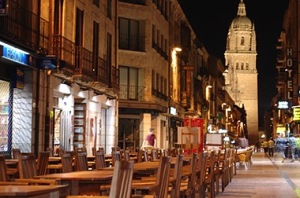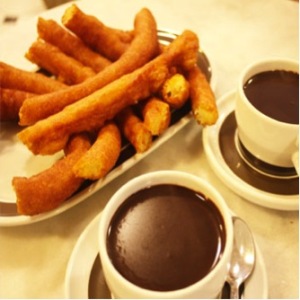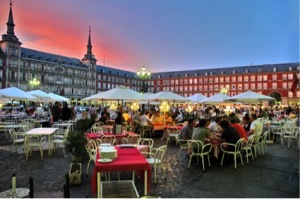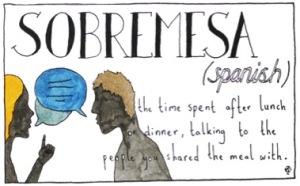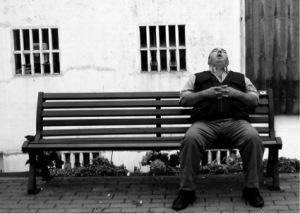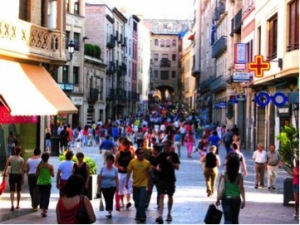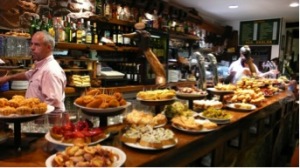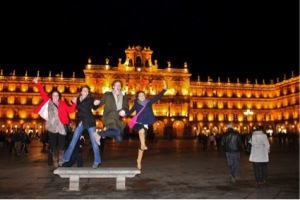Ive been living in Salamanca for two years now. It may not be a lifetime, but its long enough to become accustomed to the cultural differences between Spain and the USA.
Each time a friend or family member comes to visit me, I am reminded of how many subtle differences there are between the day-to-day lives of American and Spanish people. Studying in Mester and living with all Spanish roommates, I dove right into this culture, and I wouldn’t be surprised now if I experience culture shock when I move back home to my own country!
The Rua Mayor of Salamanca, scattered with terraces and illuminated by the lit up Cathedral.
Among many differences,some of the most shocking changes have to do with the time schedules, which overall are based on eating. Spain’s
Let’s go through a typical day.
In order to wake up in the morning, Spanish people love their caf con leche, caf cortado or Colacao (a popular hot chocolate mix). They eat a mostly liquid breakfast; with the most important part being the strong coffee. You might be used to black coffee in the US, but here dont fill your mug all the way, or you may find yourself jumpy and shaky in class due to a caffeine overload!
Coffee with milk and sugar is a typical breakfast staple. It also goes quite nicely as a mid-morning pick-me-up, an after lunch digestive or a late afternoon “merienda” with something sweet!
Try some fresh squeezed orange juice, known as zumo natural. Or experiment with pineapple or peach juice, to go with your slice of bread with butter and jam, or pan tumaca, -a mixture of grated tomato with olive oil, salt and garlic-. You can also treat yourself to some Maria breakfast cookies, a fairly plain breakfast food, which at first may seem bland to the American taste, but with time you will surely grow to love them.
Typical breakfast foods; fresh squeezed orange juice & pan tumaca.
On a special occasion, go out for breakfast and enjoy some churros con chocolate. The chocolate is extremely thick, like melted brownie batter, and the first time I saw the locals drinking it like coffee, I was shocked! The churros come in different varieties, but all are greasy. Theyre not covered in cinnamon sugar, just oil. Theyre pretty heavy for a normal day, but perfect at 8 AM after a long night of fiesta!
Chocolate con churros
In Spain, stores open between 9 and 10 AM. Don’t plan to run errands before class. And if you get out of class at 2, dont expect to run errands then either. Stores close for siesta at 2 PM, and reopen between 4 and 6 PM. This time of day is reserved for eating, and if you’re lucky, for a short nap. Since lunch is the biggest meal of the day, and you should get used to planning your whole day around it. You won’t be eating a quick PB&J, but rather a big plate of rice with veggies, pasta, meat or fish and more. Usually meals include a first and second plate, and dessert at home is fruit or yogurt. If you want to eat lunch out at a restaurant, and enjoy watching the day go by from a terraza, or terrace, try a men del da. For less than 10, depending on the city, you have a 3 course meal with wine included!
The Plaza Mayor of Madrid, filled people enjoying a meal at restaurant terraces.
After lunch, Spanish people sit around the table chatting with family in a tradition called sobremesa. At a restaurant, they take their time as well. And unlike the U.S., the waiters wont rush you out. In fact, you must flag them down when you want the check otherwise theyll let you sit there forever. Dont think theyre ignoring you just because they dont check in constantly. Waiters in Spain dont work for tips, so you dont have to leave anything, but you also must get their attention any time you need something. At least, the price of the meal is really the price of the meal.
After lunch, not everyone really goes back to bed. But those who do have time before going back to work or class, tend to take advantage of a quick siesta. 20-30 minutes is the norm. Even if you don’t sleep, take a little break and recuperate your energy to go back to work or class until 8 or 9 in the “afternoon.”
Adapting to this schedule does take some time. At first after lunch, you think you never want to go back to work! You wish you could run your errands in your free time, but your free time is also everyone else’s free time and stores are closed! After a few weeks or months, you will overcome yourinitial frustration and you’llbegin to relax into the schedule and enjoy the slower paced lifestyle. Although you may begin to agree with your Spanish friends in thinking that Spaniards really do take advantage of the day much better, you may never get over the fact that stores are closed in the middle of the day and at 8 PM everyone has to do their grocery shopping at the exact same time! Oh well, eventually you’ll make the best of the schedule and join the locals for a walk down the streets, stopping in stores, and you won’t want to go back to the American time schedule.
People walking the streets of Calle Toro, in Salamanca, close to the Plaza Mayor.
Since family time is spent at lunch, dinner tends to be more low-key. Spanish people eat dinnerconsiderably late at night by American standards, and in general it is a much lighter than in the US. While we think its crazy to eat dinner at 10 PM, Spanish people cannot comprehend how we dont starve at night if we eat dinner at 6 PM in the US! Its just a matter of getting used to the schedule. On a special occasion, dinner can consist of tapas, or small snacks, with varying specialties in each Spanish city you might visit. Order a glass of wine or a small beer, and sample delicacies from each region!
A typical tapas bar in northern Spain.
Last but not least, the final major time difference between Spain and the U.S. is that of “la fiesta!” Here, a night out is a marathon, not a sprint. A normal night in which you go to “tomar algo,” you may have a few tapas and get home by 2. But truly going out in a college town, requires much more energy and stamina. My experience in Salamanca consisted of being the only American in a dorm with 25 Spanish college students. The first night they invited me to go out, I was amazed by the relaxed pace of the night. Rather than rushing to get to the bars before they close at 2 AM, Spanish college students enjoy a “botellon,” or pregame (the word translates directly to “big bottle,”) at home and spend time with friends. They don’t leave the house before 3 AM, which for me was already way past my bedtime! At 3:30 or so, the bars just start to fill up, and in the next few hours until 7 or 8 AM, you can find bars with all kinds of music and plenty of dancing!
Friends jump for joy in the Plaza Mayor of Salamanca at night.
After pulling an all-nighter, take advantage of the Spanish alternative to window blinds, and “baja las persianas.” Since all shops (except restaurants and cafés) are closed on Sundays anyway, sleep the day away in a cool and dark room. You might be surprised by the complete lack of screens on windows in Europe, but after living in Spain you too will ask, – how can anyone sleep without persianas?! Enjoy your lazy Sunday. Sunday is not a free day in which you can check things of your to-do-list. Sunday is a day to take a walk with friends or family, eat an especially leisurely lunch or just soak up yourfree time and allow yourself to really rest. Do like the Spaniards do, take your time and enjoy!
Besides the completely different time schedule, what other things shocked you when you came to Spain?
If you’re considering studying abroad, what expectations do you have about culture shock in this new and different country? What would you like to know?
Would you rather experience it for yourself? Look into our short and long term programs, and draw your own conclusions about the best way to live!
One thing is for sure. “Se vive muy bien” in Spain.







